Pregnant Women and Flu Vaccination, Internet Panel Survey, United States, November 2016
Figure 1.
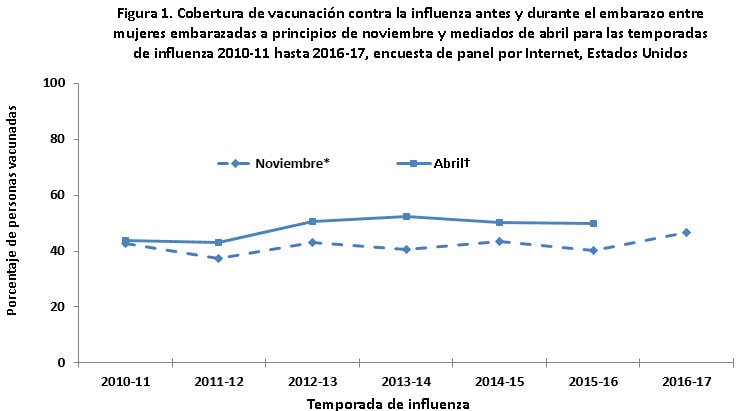
Pregnant women are at high risk of serious influenza (flu) illness including some that might result in hospitalization (like pneumonia). Pregnant women who get flu might be more likely to have certain pregnancy complications. Additionally, babies younger than 6 months also are at high risk of serious flu illness but are too young to be vaccinated (1,2).
The best way for pregnant women to protect themselves from the flu is to get a flu shot (1). A flu shot has been shown to protect pregnant women from flu illness. Additionally a flu shot given during pregnancy has been shown to lower risk of flu illness and flu-related hospitalizations in their infants for the first several months of life (1-7). ( The Centers for Disease Prevention and Control (CDC), the American College of Obstetricians and Gynecologists, the American College of Nurse Midwives, and the American Academy of Family Physicians recommend flu shots for all women who are or will be pregnant during the flu season (1,3,8).
Vaccination coverage among pregnant women has been relatively stable since the 2012–13 flu season (9).‡
To estimate flu vaccination coverage by early November 2016, CDC analyzed data on flu vaccination from an Internet panel survey conducted November 1–10, 2016, among women who were pregnant anytime since August 2016. The results of this survey provide information for use in vaccination campaigns during National Influenza Vaccination Week (December 4–10, 2016). This report provides early estimates of vaccine uptake by pregnant women. Final 2016–17 flu season vaccination coverage estimates for pregnant women will be published in September 2017.
Key Findings
- As of early November 2016, flu vaccination coverage among pregnant women before and during pregnancy was 46.6%, approximately 6 percentage points higher compared with 2015–16 early-season vaccination coverage (40.2%).
- In the previous two flu seasons, vaccination coverage increased by approximately 7–10 percentage points from the early season to the end of the season.
- Most women (98.7%) reported visiting a doctor or other medical professional at least once since July 1, 2016. Among these women, 60.2% reported receiving a recommendation for and offer of flu vaccination from a doctor or other medical professional, 14.2% received only a recommendation for and no offer of flu vaccination, and 24.3% did not receive a recommendation or an offer for flu vaccination, similar to the proportions from November 2015 (61.6%, 15.0%, and 23.4%, respectively).
- Women who reported receiving a provider recommendation for and offer of vaccination were more than twice as likely to be vaccinated compared with women who received only a recommendation but no offer of vaccination (65.7% vs. 29.8%) and six times more likely to be vaccinated compared with women who did not receive a recommendation or an offer for vaccination (65.7% vs. 11.1%).
Conclusion/Recommendation:
- Health care providers are encouraged to continue to strongly recommend and offer flu shots to pregnant women throughout the flu season to protect mothers and their infants.
Who Was Vaccinated?
Coverage by Age Group
- Younger pregnant women (18–24 years) had lower vaccination coverage (41.9%) than pregnant women 25–34 years (47.3%) and 35–49 years (51.8%).
- Compared with early November 2015, vaccination coverage in early November 2016 was similar for pregnant women 18–24 years (41.9 % vs. 37.9%), but higher than coverage for pregnant women 25–34 years old (47.3% vs. 40.0%) and 35–49 years old (51.8% vs. 44.3 %).
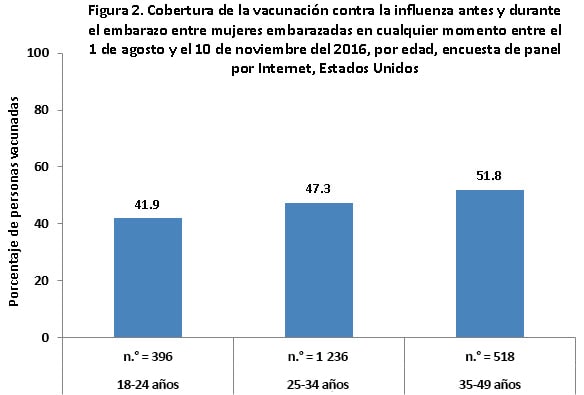
Coverage by Race/Ethnicity
- There were no differences in vaccination coverage by race/ethnicity among pregnant women in early November 2016.
- Compared with early-season 2015, vaccination coverage in early November 2016 was higher among non-Hispanic white women (45.6% vs. 39.9%) and non-Hispanic black women (45.5% vs. 32.9%), and similar for Hispanic women (49.0% vs. 44.6%) and non-Hispanic women of other race (48.3% vs. 46.4%).

Coverage by Education
- Vaccination coverage was lower among pregnant women with a high school diploma or less (38.2%) or some college (38.4%) compared with women with a college degree (49.3%) or more than a college degree (60.1%).
- Compared with the 2015 early season estimates, coverage was higher in early November 2016 for women with more than a college degree (60.1% vs. 48.4% ) and for those with a high school diploma or less (38.2% vs. 33.9%), and coverage was similar for women with some college (38.4% vs. 36.4%) and women with college degree (49.3% vs. 44.9%).
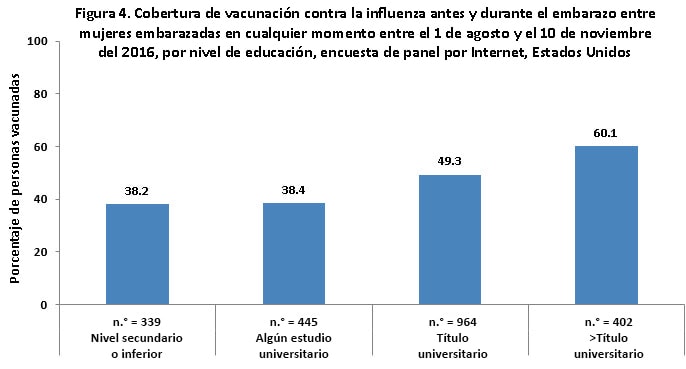
Coverage by Type of Medical Insurance
- Pregnant women who reported having only private/military insurance during pregnancy had higher vaccination coverage (48.6%) than pregnant women who reported having any type of public medical insurance (44.4%) and who reported not having insurance (36.3%).
- Approximately one in twenty-five (4.0 %) pregnant women reported not having medical insurance.
- Compared with early November 2015 estimates, coverage was approximately 7 percentage points higher in November 2016 among women with public medical insurance (44.4% vs. 37.0%). Coverage was similar in November 2016 and November 2015 among women with private/military insurance (48.6% vs.43.7%) and among women without insurance (36.3% vs. 31.6%).

Coverage by Other High-Risk Conditions§
- Women with a high-risk condition (in addition to pregnancy) that increases the risk of severe flu had higher vaccination coverage (52.6%) than women with no additional high-risk conditions (41.8%).
- Compared with the early November 2015 survey, coverage in the early November 2016 survey was higher among women with high-risk conditions other than pregnancy (52.6% vs. 44.3%), and similar to coverage among women without additional high-risk conditions (41.8% vs. 37.1% ).
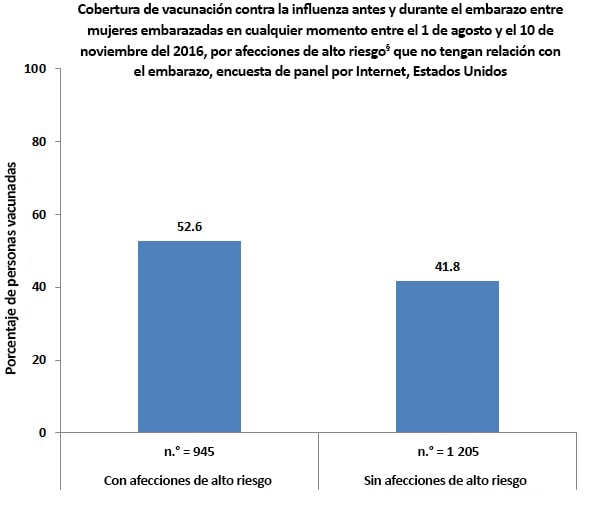
Coverage by Health Care Provider Recommendation and Offer
- Most women (98.7%) reported visiting a doctor or other medical professional at least once since July 1, 2016. Among these women, 61.0% reported receiving a recommendation for and offer of flu vaccination from a doctor or other medical professional, 14.4% received a recommendation but were not offered the vaccine, and 24.6% did not receive a recommendation for flu vaccination. These results were similar to the early November 2015 survey.
- Flu vaccination coverage among pregnant women was highest (65.7%) among women who reported their doctor or other medical professional recommended and offered the vaccination.
- Among pregnant women who reported they received a recommendation for but no offer of vaccination from their doctor or other medical professional, 29.8% were vaccinated.
- Only 11.1% of pregnant women were vaccinated among those that reported they did not receive a recommendation for vaccination from their doctor or other medical professional.
- Vaccination coverage among those who received a provider recommendation and offer of vaccination (65.7%) or among those who received a recommendation only (29.8 %) were higher in November 2016 compared with November 2015 (58.8% and 20.1%, respectively).
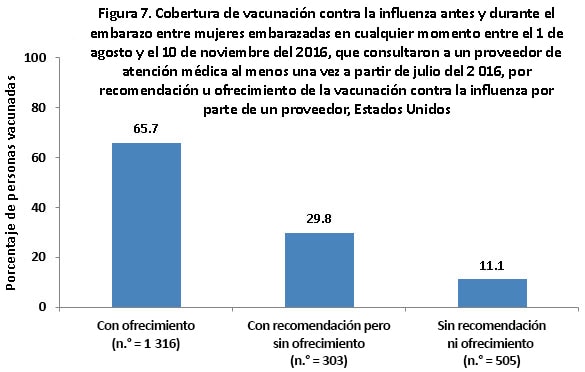
Place of Vaccination
The most common reported place by pregnant women who received flu vaccination before and during pregnancy was in the office of an obstetrician/gynecologist or midwife (36.6%).
- The reported places for receiving flu vaccination during pregnancy were similar in early November 2016 compared with early November 2015.
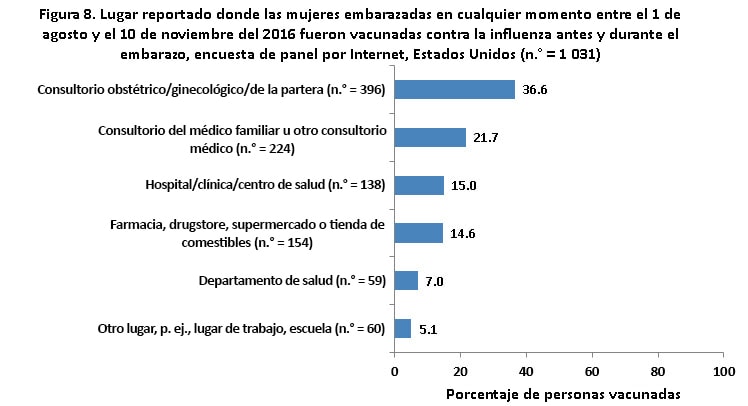
Main Reason for Receiving Vaccination
Respondents who had been vaccinated by the time of the survey were asked to report their main reason for receiving a flu vaccination.
- The most commonly reported reason for receiving a flu vaccination was to protect their infants from flu (33.8%).
- The second most commonly reported reason was to protect themselves from flu (22.5%), and the third most commonly reported reason was that their health care provider recommended vaccination to them (17.6%).
- The top three main reasons for vaccination were the same in the early November 2015 survey, with proportions of 36.0%, 22.9% and 17.3%, respectively
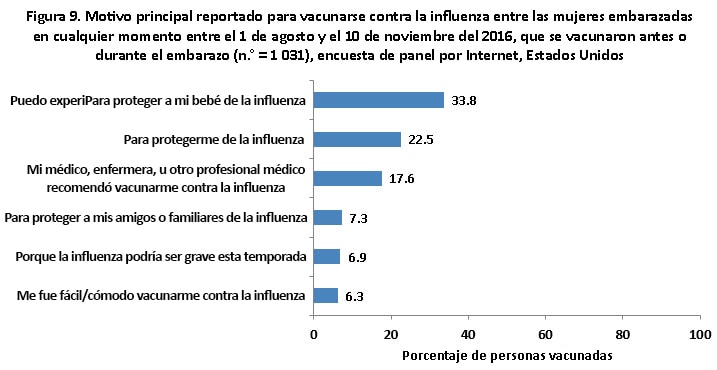
Main Reason for Not Receiving Vaccination
Unvaccinated respondents who reported that they did not intend to be vaccinated during this flu season|| were asked their reasons for not receiving or not planning to get a flu vaccination:
- The most commonly reported reason for not receiving or not planning to get a flu vaccination was belief that the flu vaccine is not effective in preventing the flu (18.2%).
- The second most commonly reported reason for not receiving or not planning to get a flu vaccination was concern about possible safety risks to their infants (17.2%).
- Two other reasons commonly reported by respondents were concern about getting sick from the flu vaccination (15.5%) or not being concerned about getting the flu (12.2%).
- Barriers to vaccination access, such as lack of medical insurance or cost of the vaccine, lack of time, unavailability of the vaccine, and lack of knowledge regarding where to get the vaccine were rarely reported as a main reason for not receiving a flu vaccination.
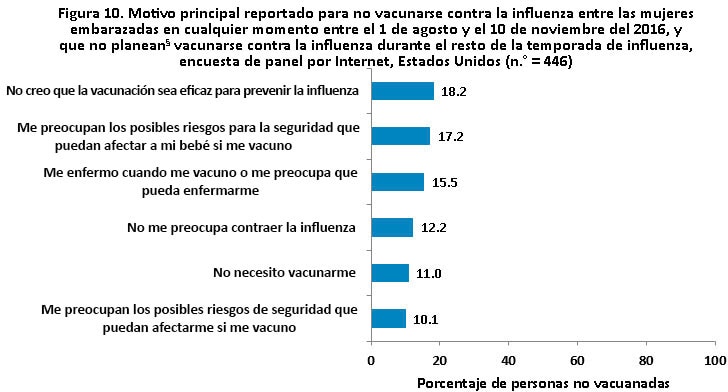
What Can Be Done?
Overall, early 2016–17 season estimates of flu vaccination coverage before or during pregnancy among women pregnant any time from August 2016 through the time of the survey were higher than the 2015–16 early season estimates; however, more than half of pregnant women remain unvaccinated. As in the prior season, flu vaccination coverage was highest among pregnant women who reported that their doctor or other medical professional recommended and offered the flu vaccination (65.7%), emphasizing the importance of providers’ recommendations. Yet, 24.6% of pregnant women reported that they did not receive a recommendation for vaccination. Concerns about the effectiveness of the flu vaccine and concern about the safety of vaccination to their infants were the most commonly reported reasons for not getting a flu vaccination (reported by 18.2% and 17.2% of unvaccinated respondents, respectively). To improve flu vaccination coverage among pregnant women:
Medical professionals are reminded to implement the National Vaccine Advisory Committee’s Standards for Adult Immunization Practices (10):
- Assess the vaccination status of pregnant women at each visit.
- Standing orders and provider reminders can be used to ensure each patient vaccination status is assessed at every visit (11).
- Strongly recommend flu vaccination and provide information about:
- The risk of flu and related complications for pregnant women and their infants, including severe illness in pregnant women and flu-related illness and hospitalization in their infants;
- The benefits and risks of flu vaccination for mothers and their infants;
- The protection transferred to infants by vaccination during pregnancy, since infants younger than 6 months old cannot be vaccinated themselves.
- The safety of flu vaccine for pregnant women.
- Offer flu vaccination or refer women to another provider who can give the vaccination.
- Ensure that receipt of vaccination is documented in the patient medical record and immunization registry.
Medical professionals should vaccinate pregnant women and others throughout the flu season:
- More than half of the pregnant women in this survey had not been vaccinated as of early November.
- Providers should continue to encourage their unvaccinated patients, including pregnant women and the contacts and caregivers of pregnant women and their infants, to receive a flu vaccination as soon as possible, before flu activity increases in their community. Peak flu activity in the United States most often occurs from December through February, and activity can last as late as May.
- Providers should continue to offer flu shots to unvaccinated pregnant women for the duration of the flu season even if flu activity has decreased in their community, since more than one type or subtype of flu may cause illness in a single flu season.
Information is available at:
- American College of Obstetricians and Gynecologists. Flu shot for pregnant patients: frequently asked questions [970 KB, 2 pages].
- American College of Obstetricians and Gynecologists. Physician script on influenza immunization during pregnancy. Washington, DC: American College of Obstetricians and Gynecologists; 2013 [946 KB, 2 pages].
- American College of Nurse-Midwifes, Immunization Resources for Providers.
- Pregnant Women and Influenza (Flu)
- Pregnant Women and the Flu Shot: Fact Sheet [780 KB, 2 pages]
- Influenza Vaccination of Pregnant Women: Letter to Providers [260 KB, 2 pages]
- Tips for Mom with support throughout pregnancy through free text messages on topics like prenatal care, baby health, parenting, vaccination, and more.
The November Internet panel survey of pregnant women is designed to provide timely estimates of national flu vaccination coverage and to assess the effectiveness of current vaccination efforts. The follow-up survey in April 2017 will provide end-of-season flu vaccination coverage estimates.
Data Source and Methods
CDC conducted an Internet panel survey from November 1–10, 2016, to provide early season estimates of flu vaccination coverage and information on knowledge, attitudes, and behaviors related to flu vaccination among pregnant women. Women 18–49 years who were pregnant at any time since August 1, 2016 were recruited from SurveySpot, a general population Internet panel. SurveySpot is the same recruitment mechanism that was used in the November 2015 survey. Eligible respondents were either pregnant at the time of the survey or had recently been pregnant. Of 2,233 panel members who were eligible and started the survey, 2,150 (96.3%) completed the online survey. Data were weighted to reflect the age, race/ethnicity, and geographic distribution of the total U.S. population of pregnant women (12-15).
Survey respondents were asked if they had a flu vaccination since July 1, 2016, and if yes, in which month and whether they received the vaccination before, during, or after pregnancy. Pregnancy status questions included whether respondents were currently pregnant at interview or had been pregnant anytime since August 1, 2016. Women who reported receiving vaccination since July 1, 2016, and who were vaccinated before or during pregnancy were counted as vaccinated. All respondents were asked if their doctor or other medical professional had recommended or offered the flu vaccine. They were also asked about their attitudes toward and beliefs about flu and flu vaccination.
Weighted analyses were conducted using SAS (version 9.3) survey procedures. Because the opt-in Internet panel sample was based on those who initially self-selected for participation in the panel rather than a random probability sample, statistical measures such as calculation of confidence intervals and tests of differences were not performed (16). A difference of five percentage points was considered a notable difference.
Sample Demographics
- A total of 2,150 women pregnant any time from August 1–November 10, 2016 were included in the survey, with sample sizes and weighted percentages by demographic variables as follows:
- By age, 396 (28.8%) were 18–24 years, 1,236 (53.5%) were 25–34 years, and 518 (17.7%) were 35–49 years, similar compared with the November 2015 survey (28.7%, 53.5%, 17.7% respectively).
- By race/ethnicity, 393 (21.9 %) were Hispanic, 1,381 (50.9 %) were non-Hispanic white, 206 (19.5%) were non-Hispanic black, and 170 (7.7%) were non-Hispanic other race/ethnicity, similar to the November 2015 survey (21.7%, 50.9%, 19.5% and 7.7% respectively).
- By education, 339 (17.4%) were women with high school diploma or less education, a lower percentage than in the November 2015 survey (25.0% ); 445 (23.0%) were women with some college education but without a degree, similar to the November 2015 survey (27.7%); 964 (43.7%) were women with a college degree, higher than that in the November 2015 survey (36.7%); and 402 (15.9%) were women with greater than a college degree, higher than in the November 2015 survey (10.5%).
- By type of medical insurance, 1,301 (56.9%) were women with private or military insurance only, higher than in the November 2015 survey (49.6%), 762 (38.7%) were women with any public insurance, lower than that in the November 2015 survey (46.3%), and 78 (4.0%) were women with no insurance, similar to the November 2015 survey (3.6%).
- By high-risk conditions other than pregnancy,‡ 945 (43.7%) were women with high-risk conditions, higher than that in the November 2015 survey (32.7%) and 1,205 (56.3%) were women without high-risk conditions, lower than that in the November 2015 survey (61.3%)
Limitations
These results are preliminary and should be interpreted with caution. The follow-up Internet panel survey in April 2017 will assess flu vaccination coverage at the end of the flu season.
The findings in the report are subject to several limitations.
- The sample was not necessarily representative of all pregnant women in the United States, because the survey was conducted among a smaller group of volunteers who were already enrolled in SurveySpot rather than a randomly selected sample.
- Some bias might remain after weighting adjustments, given the exclusion of women with no Internet access and the self-selection processes for entry into the panel and participation in the survey. Estimates might be biased if the selection processes for entry into the Internet panel and a woman’s decision to participate in this particular survey were related to receipt of vaccination.
- All vaccination results are based on self-report and not validated by medical record review. Estimates from Internet panel surveys may not be directly comparable to estimates from population-based surveys because of the difference in sampling between the surveys. However,
- The estimates of flu vaccination coverage among women pregnant anytime during October 2010-January 2011 from the same 21 states in both PRAMS and the Internet panel survey were similar (45.6% vs. 44.9%) (17).
- Compared to the estimates from the BRFSS, flu vaccination coverage estimates among pregnant women from the Internet panel survey were similar for the 2010-11 flu season (43.9% from the Internet panel survey vs. 39.7% from BRFSS), 2011-12 flu season (43.2% vs. 39.0%), and in 2014-15 flu season (50.3% vs. 48.7%), but higher in the 2012-13 flu season (50.5% vs. 39.9%), and the 2013-14 flu season (52.2% vs. 46.4%). (CDC, unpublished data).
Despite these limitations, Internet panel surveys are a useful surveillance tool for timely early season and post season evaluation of flu vaccination coverage and knowledge, attitude, practice, and barrier data.
AUTHORS: Helen Ding, MD, MSPH1; Carla L. Black, PhD2; Sarah W. Ball, ScD3; Rebecca Fink, MPH3; Amy Parker Fiebelkorn, MSN, MPH2; Carolyn B. Bridges, MD2 ; Katherine E. Kahn, MPH4 ; Peng-Jun Lu, MD, PhD2; Walter W. Williams, MD, MPH2; Denise D’Angelo, MPH5; Stacie M Greby, DVM,MPH2;
1CFD Research Corporation, Huntsville, AL
2Immunization Services Division, National Center for Immunization and Respiratory Disease, CDC
3Abt Associates Inc., Cambridge, MA
4Leidos, Atlanta, GA
5Division of Reproductive Health, National Center for Chronic Disease Prevention and Health Promotion, CDC
Related Links
- American College of Obstetricians and Gynecologists. Flu shot for pregnant patients: frequently asked questions. Washington, DC: American College of Obstetricians and Gynecologists; 2013.
- Pregnant? Get a flu shot
- Standards for Adults Immunization Practice
- Influenza vaccination coverage: FluVaxView
- 2015-16 end-of-season online report
- 2015-16 early season online report
- 2014-15 end-of-season MMWR
- 2014-15 early season online report
- 2013-14 end-of-season MMWR
- 2013-14 early season online report
- 2012-13 end-of-season MMWR
- 2012-13 early season online report
- 2011-12 end-of-season MMWR
- 2011-12 early season online report
- 2010-2011 end-of-season MMWR
- 2010-2011 early season online report [427 KB, 6 pages]
- Flu vaccination accepted by pregnant women not linked with miscarriage
- Pregnancy Risk Assessment Monitoring System website
- Prevention and Control of Influenza with Vaccines: Recommendations of the Advisory Committee on Immunization Practices (ACIP)-United States, 2013-14 influenza Season
- Text4Baby
- SSI
- SurveySpot
- Follow CDC Flu on Twitter: @CDCFlu
References/Resources
- Groshkopf LA, Sokolow LZ, Broder KR, et al. Prevention and control of seasonal influenza with vaccines: recommendations of the Advisory Committee on Immunization Practices–United States, 2016-17 influenza season. MMWR Recomm Rep 2016;65(No. RR-05):1–54.
- Poehling KA, Edwards KM, Weinberg GA, et al. The underrecognized burden of influenza in young children. N Engl J Med 2006;355:31-40.
- American College of Obstetricians and Gynecologists. Immunization for women. Accessed November 28, 2016.
- Zaman K, Roy E, Arifeen SE, et al. Effectiveness of maternal influenza immunization in mothers and infants. N Engl J Med 2006;355:31-40.
- Poehling KA, Szilagyi PG, Staat MA, et al. Impact of maternal immunization on influenza hospitalizations in infants. Am J Obstet Gynecol 2011;204(6 Suppl 1):S141–8.
- Madhi SA, Nunes MC, Cutland CL. Influenza vaccination of pregnant women and protection of their infants. N Engl J Med. 2014 Dec 11;371(24):2340.
- Tapia MD, Sow SO, Tamboura B et al. Maternal immunisation with trivalent inactivated influenza vaccine for prevention of influenza in infants in Mali: a prospective, active-controlled, observer-blind, randomised phase 4 trial. Lancet Infect Dis. 2016 Sep;16(9):1026-35.
- American College of Obstetricians and Gynecologists. Influenza vaccination during pregnancy. Committee Opinion No. 608 Obstet Gynecol 2014; 124:648–51. Joint statement for pregnant women about Influenza.
- Ding H, Black CL, Ball S, et al. Influenza vaccination coverage among pregnant women— United States, 2015–16 influenza season. FluVaxView. Accessed November 28, 2016.
- National Vaccine Advisory Committee. Recommendations from the National Vaccine Advisory Committee: Standards for Adult Immunization Practice. Public Health Rep 2014;129:115-23.
- The Guide to Community Preventive Services: http://www.thecommunityguide.org/vaccines/healthsysteminterventions.html. Accessed November 30, 2016.
- Guttmacher Institute. Total pregnancies by occurrence includes total births, abortions by occurrence and miscarriages Available at: http://www.guttmacher.org/datacenter.
- Hamilton BE, Martin JA, Osterman MJK et al. Births: Final data for 2014. National vital statistics reports; vol 64 no 12 [2.8 MB, 64 pages]. Hyattsville, MD: National Center for Health Statistics. 2015. Accessed November 28, 2016.
- Curtin SC, Abma JC, Ventura SJ et al. Pregnancy rates for U.S. women continue to drop. NCHS data brief, no 136. Hyattsville, MD: National Center for Health Statistics. 2013. Available at: https://www.cdc.gov/nchs/data/databriefs/db136.pdf [436 KB, 8 pages].
- Curtin SC, Abma JC, & Kost K. 2010 pregnancy rates among U.S. women (supplemental table). NCHS Health E-Stat. 2015. Accessed November 28, 2016.
- American Association for Public Opinion Research. Report of the AAPOR Task Force on non-probability sampling. Accessed November 28, 2016.
- CDC. Seasonal influenza vaccination coverage among women who delivered a live-born infant–21 states and New York City, 2009-2010 and 2010-11 influenza seasons. MMWR 2013;62:1001-4.
Footnotes
*The November trend line indicates flu vaccination coverage estimates before and during pregnancy among women who provided a response to vaccination status questions and who were pregnant any time from August to November during the 2010–11 flu season (n=1,496), 2011–12 flu season (n=2,047), 2012–13 flu season (n=1,796), 2013–14 flu season (n=2,096), 2014–15 flu season (n=2,109), 2015–16 flu season (n=2,116), and 2016–17 season (n=2,150). Beginning in the 2012–13 season, women vaccinated from July 1 to early November were counted as vaccinated. In prior seasons, only women vaccinated from August 1 to early November were counted as vaccinated.
†The April trend line indicates flu vaccination coverage estimates before and during pregnancy among women who provided a response to vaccination status questions and who were pregnant any time from October to January during the 2010–11 flu season (n=1,457), 2011–12 flu season (n=1,660), 2012–13 flu season (n=1,702), 2013–14 flu season (n=1,619) 2014–15 flu season (n=1,702), and 2015–16 flu season (n=1,692). Beginning in the 2012–13 season, women vaccinated from July 1 to mid-April were counted as vaccinated. In prior seasons, only women vaccinated from August 1 to mid-April were counted as vaccinated.
‡Vaccination coverage among women vaccinated before or during pregnancy measured by the Internet panel surveys was 43.9% in the 2010–11 flu season, 43.2% in the 2011–12 flu season, 50.5% in the 2012–13 flu season, 52.2% in the 2013–14 flu season, 50.3% in the 2014–15 flu season, and 49.9% in the 2015–16 flu season.
§Currently have conditions, other than pregnancy, associated with increased risk for serious medical complications from influenza, including chronic asthma, a lung condition other than asthma, a heart condition, diabetes, a kidney condition, a liver condition, a weakened immune system caused by a chronic illness or by medicines taken for a chronic illness, or obesity.
||Includes unvaccinated respondents who reported that they probably or definitely do not intend to be vaccinated before the end of the flu season.
